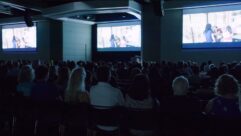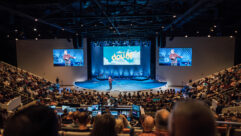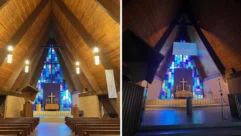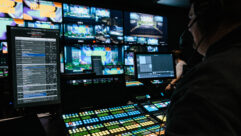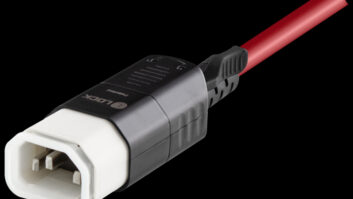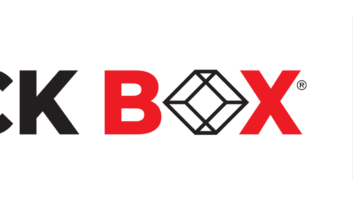
Grace Polaris Church in Columbus, OH had outgrown the worship space and the team was setting up an all-new facility. The original plan did not center on streaming video but it was included in the build-out when some savings freed up from other parts of the project. Now that capability is getting the congregation through a very tough time. Phil Hagood, General Manager at InteRise and Brent Dye at Grace Polaris Church are here to give us the story on how they’re doing it.
SVC: Philip and Brent, thanks to both of you for joining us today. Philip coming to us from Nashville, Tennessee at InteRise.
Philip Hagood: Yes, sir.
And Brent is joining us from the Columbus, Ohio area at Grace Polaris Church.
Brent Dye: That’s correct.
Alright, good to have you both on with us. We’re talking about a major renovation, a new worship space for Grace Polaris Church. As I understand it, something very fortunate happened that wasn’t fully planned. Before we dig into the details there, Phil tell us about InteRise and Morris Light and Sound.
Philip: Yes. InteRise is a new brand name for Morris Integration, which in turn grew out of Morris Light and Sound– a rental company that has been around for about 25 years. In the last decade, we’ve taken a new approach in how we do business. As Morris Integration we started to focus on fixed installs for AVL systems, primarily for the house of worship market. What we found is as both the brands grew–the rental side of the company, and the install side of the company–it made sense to create some differentiation in our name. So we’ve rebranded, as of the first of this year, as InteRise. We’re excited about the new opportunities that that gives us but we still continue to be the same team, the same core group and we continue to have a specific and really exciting focus on the house of worship market both in renovations and in new construction for AV systems.
This was a very big project at Grace Polaris Church. Brent, you’re right in the middle of this, being the audio guy there so what sort of worship style do they have at Grace Polaris Church?
Brent: The worship style is very eclectic. We come from a long history of traditional music as well as contemporary Christian music. We have two services and the biggest difference is just in the styles of music for those two services. The first service is more traditional, so we’ve got the full choir, orchestra; we do a lot of hymns, big orchestral numbers. And then in the second service it’s a bit more contemporary; a worship band, worship singers. Sometimes we will have the orchestra back us up a little bit on some of those worship songs. Sometimes we just have the worship band and we may bring in a few members of the brass section just to kind of spice things up and make it fun for everybody. We’re really trying to involve as many people as possible in the worship process and we’ve got such a pool of talented people from which to draw it’s really been a blessing. We’ve been in need of a worship center renovation for a long time. The building was originally built in 1983 and we still had a lot of the same AV components. We contacted Morris because we needed something more than what just the local tech group could do for us. As we talked, they understood exactly what we needed and came up with several different options that would meet our budget and have the desired outcome for all of the equipment, sound, video, and lighting. I think we started that process a little over two years ago in the planning stages and things are finally all in place.
Nobody could have foreseen a global pandemic with churches having to shut their doors to live attendance. The worship experience is a very social thing with a lot of physical interaction. While installing live streaming capability wasn’t the main objective, it seems now to have been a very fortunate addition.
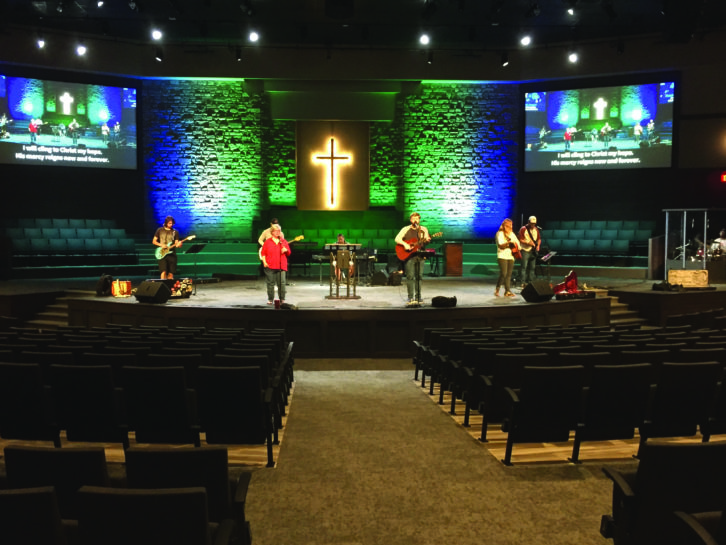 Brent: Yes. Yes, it definitely is. It’s been a real Godsend. Before we really didn’t have proper facilities and equipment to do a quality livestream. We were still analog-based. A lot of the cameras were still 4 x 3. And so having all new equipment has been a real game-changer for us to be able to do this. What we’re doing at the moment is not actually a livestream. We are actually recording on Thursday evenings and then we do necessarily editing and post it to the web site. And then at 9:00 a.m. on Sunday it’s ready to go.
Brent: Yes. Yes, it definitely is. It’s been a real Godsend. Before we really didn’t have proper facilities and equipment to do a quality livestream. We were still analog-based. A lot of the cameras were still 4 x 3. And so having all new equipment has been a real game-changer for us to be able to do this. What we’re doing at the moment is not actually a livestream. We are actually recording on Thursday evenings and then we do necessarily editing and post it to the web site. And then at 9:00 a.m. on Sunday it’s ready to go.
That’s a very smart thing to do because you can clean up in editing any problems with the mix or the cameras or any other technical glitches. Phil, what was your plan for the online video component, and how did you manage to get more resources into that component before it became so essential?
Philip: Yeah, it’s an interesting question for this project and honestly many of the projects that we do in the house of worship market. It’s always that balance between the online cloud audience and the in-person audience when it comes to a worship experience. Having that engagement and having that personal connection with each other is a huge part of the corporate worship and the corporate church environment. That’s what makes it so powerful and so important to day-to-day faith and Christianity. So in the case of Grace Polaris they’re not a church that has 30 other satellite campuses like some of the more modern churches that we see nowadays. But they want to focus on having a really quality product inside the room. Part of that is making sure video, IMAG, those kind of things, are done in a way that’s clear and not distracting–in a way that’s engaging. Because when you talk about a larger space, having that connection to somebody’s face and eyes in an expanded, magnified image is so important. So that was the focus to start out with. But through budget revisions and going through the typical process of a large renovation or construction project, we made sure to maintain the infrastructure and the bones, but we cut back to a very small number of cameras. We cut back to some limited functionality. Then when we got into the latter stages of the project we were able to find some cost savings inside the AV system, specifically the PA system. Also the construction project as a whole was able to find some savings. So the church pushed resources back into upgraded cameras and really making sure to utilize more of that video infrastructure that was going in. So that’s allowed us to be where we are now. And once churches are meeting back in person they’ll have a fantastic product in the space. In the meantime, they have everything that’s needed to really push out a great product so the people can sit in their living room and connect. We’re all so used to watching Netflix or HD cable–high quality content. So when we put worship—or even work or meetings–into that home setting, the expectation can be really high. The video infrastructure allows Grace Church to push up to that quality level. If they hadn’t done this upgrade, it would have been really challenging to have good, clear communication and connection via technology.
Of course when people do eventually get back into the church they’re going to hear all of those familiar acoustics which is another kind of quality experience. Brent, at Grace Polaris how does the place actually sound? What’s the general sound system design there?
Brent: In a word the acoustics are great now. It’s so much different than what we’ve been used to. We used to have a lot of slap echo and things coming back to the performers on the stage that were delayed by oh, probably a good second and a half. And with all of the room treatments now it’s great. You can go anywhere in the room and you don’t have the flutter echoes in the corners that we used to have. It’s a quiet-sounding room, but it’s very well-balanced and it just has a very nice feel to it. I told somebody that when we first fired up the PA it felt like I was sitting in a large studio listening to very large studio monitors. And it’s really translated very well in the mixes that we’ve been getting out of there. We haven’t had a chance to get a full choir and orchestra up there so I can’t really compare with what we had before because there was an awful lot of acoustic energy coming from the stage. But right now, the stuff that we’re getting and the things that I’ve been able to record just as a reference mix have been excellent. And we do have the Pro Tools rig hooked up to it so we can multi-track everything that comes into the console and then play that back to do virtual sound checks.
I notice you have an Avid S6L-32D console. Why was that particular one chosen?
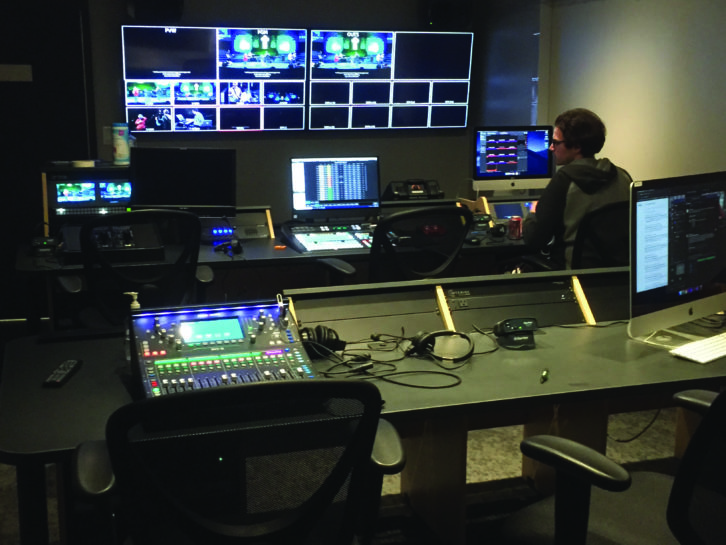 Brent: Well, back in 2006 we installed what was then Digidesign Venue D-Show. We’ve been using that for many, many years and just really grew to love that console. And all of our volunteers were trained on that and were very comfortable with it. I was interested in maintaining that familiarity with the software so we looked into the S6L and they’ve taken that whole Venue system to the next level and it is just a very nice console. Very powerful, great-sounding mic pres, excellent converters and it’s very user-friendly. You can walk up to it and in very short time you can be comfortable to do just about anything on that board that you need to do. There’s nothing that’s any more than two clicks away.
Brent: Well, back in 2006 we installed what was then Digidesign Venue D-Show. We’ve been using that for many, many years and just really grew to love that console. And all of our volunteers were trained on that and were very comfortable with it. I was interested in maintaining that familiarity with the software so we looked into the S6L and they’ve taken that whole Venue system to the next level and it is just a very nice console. Very powerful, great-sounding mic pres, excellent converters and it’s very user-friendly. You can walk up to it and in very short time you can be comfortable to do just about anything on that board that you need to do. There’s nothing that’s any more than two clicks away.
And how does the Ableton Live software work? How do you use that?
Brent: Well, the worship band has been using that for a number of years just giving them a click and cues in their ears. But they would send a loop to the PA so that we could just supplement what they were doing. We’re actually going to expand that a little bit and use orchestration stems with our orchestra. So if we wanted to add a little bit more to the string section we can do that. If we wanted to supplement some extra guitars or some extra percussion instruments we’ll be able to do that via Ableton. Everything is run via Dante and we have Dante Virtual Sound Card loaded on the computer that is running Ableton. Therefore we can just select what tracks we want to send to the console and we’re good to go.
OK and you have separate mixes, I assume, for the streaming and for the local house mix?
It’s somewhat separate but somewhat the same. What we’ve done is taken the stem mixes off of the subgroups of the FOH console. So we’ll have a group output for strings, brass, woodwinds, drums, bass, etc. And someone will be back in the video room on the broadcast console and they’ll rebalance what we’re sending them from FOH to help better fit the audio that’s required for the video. As you probably know, when working in the room with a lot of live instruments you may not necessarily need to push the brass that hard in the room to get it to balance with everything else. But in the video world, where they’re getting no acoustic energy from the room, they may need to boost the brass in order to make it fit in with everything else. So that’s the kind of thing we’ve done and so far it’s worked out very well.
Phil, on the installation end of this, what changes have you had to make to be sure that you can work as safely as possible during this pretty weird time?
Philip: Right. It’s a good question right now. It’s been challenging and tricky– that could probably be said for every person in every business across the world right now. But we’ve actually had our entire team grounded for about the last six weeks just in an abundance of caution to make sure that we’re prudent and not making too quick or too slow a decision. But when it comes to our team and their interaction with our clients that is the number one focus of my role and responsibility and the number one focus of our team leadership. So we’ve tried to make sure that we took adequate time to figure out the landscape of the changing world around us. Just this week some of the install crews have headed back out to continue moving forward on some of these projects, moving to some new projects around the country that are video-focused for this time. We’ve developed a protocol in line with what the CDC has put together to make sure that workers are protected or adequately monitoring and we’re giving everybody the opportunity and the equipment to make sure that they’re safe. If something does come up in the way of illness, whether it’s just a cold, the flu, or anything more serious, we’re allowing for a lot of flexibility. We can make sure people are treated if they are sick, but prevention being our number one goal right now. But yeah, making sure people have masks and hand sanitizer and they keep their workspace clean. So it’s definitely been tricky, though, to balance all that and make sure we can still serve the people we need to serve while still being safe and wise.
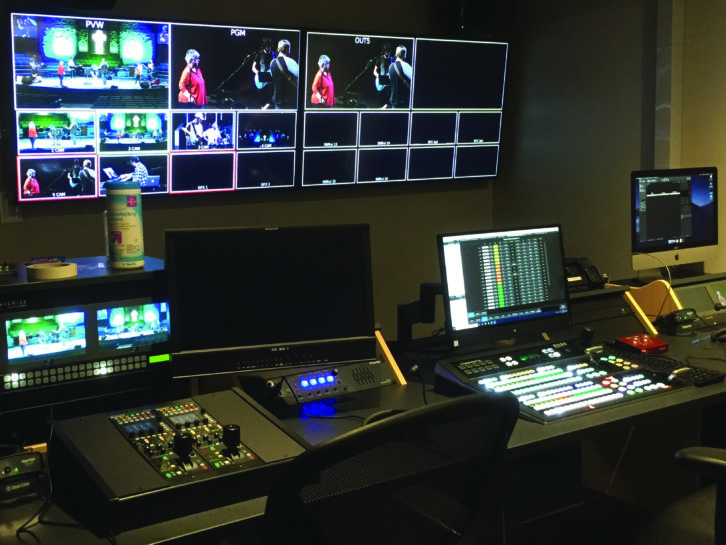 And Brent, I know you’re taking precautions on the production end as well.
And Brent, I know you’re taking precautions on the production end as well.
Brent: Yes. There’s been a whole lot of Clorox wipes and Purell hand sanitizer being used. In the production booth for video, I think the guys are stationed in separate corners of the room and they’re working with a skeleton crew so they’re trying to use as few people as possible to get the job done. Back at FOH it’s not so bad. It’s a rather large booth and it’s only me and the lighting person in the booth and we’re a good 10 feet apart. So not a problem there. Musicians on stage are staying roughly six to eight feet apart and so far it’s been working very well.
How large a production crew do you have on site for streaming the services?
Brent: For the time being, because we are working with a skeleton crew, I believe there are four people in the video production booth and two people in the auditorium on manned cameras. For the audio side there is one person in video production who is doing the broadcast mix, and then I am out at FOH doing the house mix.
Phil, let’s come back to video gear for a moment. You put in the Sony HXC-FB80 cameras and the Ross PIVOTCams. Was that decision driven by cost or features?
Philip: Yeah. Like with so many things a combination of both. The way the project started out we wanted the ability to have infrastructure for four manned cameras inside the room but also have the ability to add additional cameras in the lobby or ancillary spaces for remote connectivity in the future. So as the project went through value engineering and as we adjusted the budget we actually ended up changing back to a PTZ-focused system, the Ross PIVOTCams. We left the infrastructure for the manned cameras, but there were’nt a lot of resources put into manned cameras. As the project went on, and with the cost savings I mentioned, they were able to expand into two of the four Sony FB80 cameras as well as three or four PIVOTCams around the space to pick up some ancillary shots. The feature set of both of those cameras and the way that they work together inside of the switcher is really great and something that has been a really effective combo for us. The PIVOTCams allow direct integration with the Ross switcher and Ross Dashboard Control software, which makes it easy to operate a lot of their products together in a unified IP-based platform. And then the Sony FB80 cameras are fantastic. It’s a relatively new product for Sony, so it provides a really great 1080 image. It allows us to have that Sony kind of quality look, even at a more entry-level price point. You’re able to get a lot of the feature set of the $100,000 camera and not have to spend $100,000 for that higher tier broadcast camera platform. And then we’ve been able to make these cameras look really good together because the Ross Carbonite switcher at the central hub of the whole video system has color correctors and some of those other things as part of the software. So we can tweak and paint the cameras. Then also on the switcher side, we make some final adjustments to really make sure you have consistent image as you cut through the cameras. So it’s really exciting how they’ve all worked together and it gives them six or eight angles to be able to cut through, both in remote broadcast right now and then once they have people back in the room.
How did you set up the AV network?
Philip: There are a couple of different protocols we’re working with. Most of our designs are focused on a concept of simplicity but robustness. It’s really easy for all of us that are technical people and engineers to come up with these really intricate systems and gear that can do 45 things. I would rather have one piece of gear that does one or two things really, really well. So we have a lot of interconnection between these systems that allow you to move a lot of things around, while focusing on video distribution via SDI around the facility. So that’s both inside the room, with just basic connectivity to cameras and displays, and then also outside the room to ancillary rooms, cry rooms, choir rooms, the lobby, things like that, it’s all SDI distribution with audio embedded on the SDI. The actual audio side the system is driven by a QSC Q-SYS processor. So Q-SYS has a Q-LAN protocol that allows us to also push audio around the facility by IP. We have that capability, but we’re relying more on the Dante side that’s connected directly to the console system, with Ableton and some of those connectivity pieces where we have a lot of CAT5, CAT6 infrastructure. Then lastly on the lighting side, we’re using streaming ACM through Pathway. Pathway is a manufacturer that makes a lot of different lighting infrastructure components. So that also allows distribution by IP. Basically, as long as we have fiber and CAT and network switches in the places that we need them we can get virtually anything that’s audio, video, or lighting-related connected and controlled in those different locations. However we also keep it separated enough so the number of failure points are broad. So if, God forbid, something were to fail we don’t take down the entire building, the entire system, because we put everything on one protocol. We still keep it separated enough so that it’s easy and flexible, but also really robust.
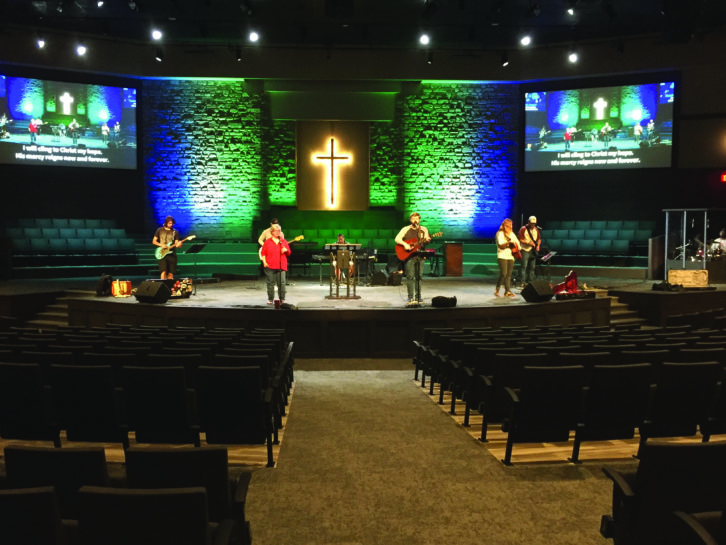 Brent, we’ve talked about how you do the services. Are there other events that are streamed in there as well or do you just concentrate on the two services for Sunday?
Brent, we’ve talked about how you do the services. Are there other events that are streamed in there as well or do you just concentrate on the two services for Sunday?
Brent: In the past we haven’t really done any streaming just because of the low quality, the cameras that we had. So this is really new territory for us and so far we’re very pleased with the results we’re getting. We look forward to doing some more.
Does it appear to you that the younger members of the congregation tend to take to the streaming more than the traditional members? How has the reaction from the congregation been to this?
Brent: You know, I don’t have the hard numbers in front of me but I had heard the first week we had quite a few people that had tuned into the stream. We’ve tried to make it as simple as possible for everybody by sending out an email with a link so all they have to do is click on the link and it will take them right to the video that’s online. We’ve had a lot of people watching on their phones, others on their iPads, some on their computers and there are some that will stream it to their TV. So everybody is getting involved. I know several of the older folks are more comfortable with the computer. My parents are sitting there watching it on the computer, so yeah it seems to be working out for everybody.
Churches will be watching each other to see what ideas there are. Both installation and production will be facing some creative challenges. Great having you both here to talk about this. Lots of questions up in the air right now. Congratulations to you both on a great job in a weird situation we have. Thanks for being with us.
Brent: Thank you very much for having us.
Philip: Yeah, thank you. We’re really grateful to be featured and really grateful for the partnership with Grace Polaris.


